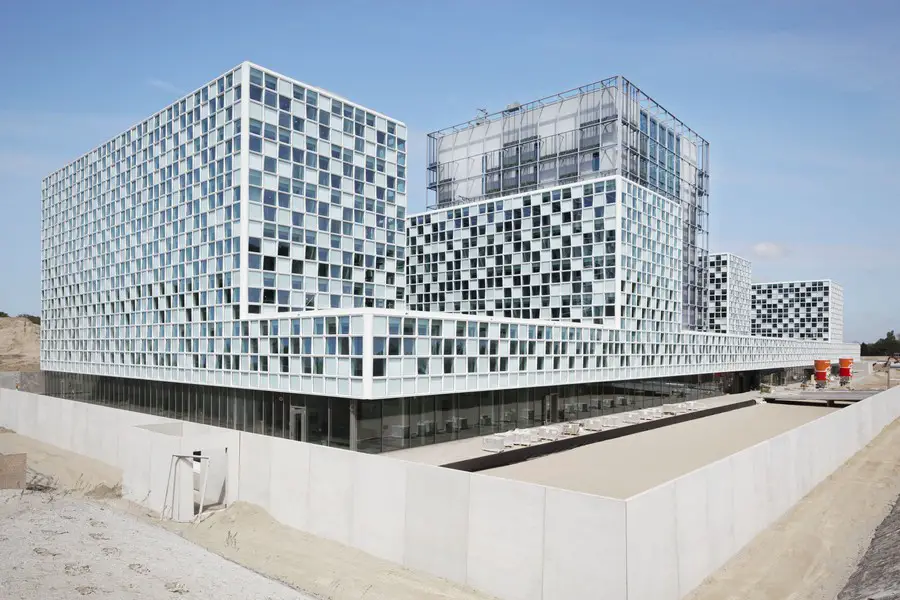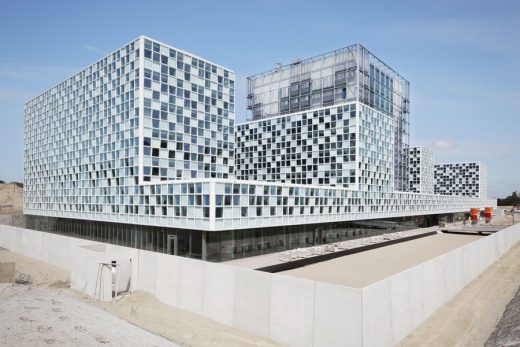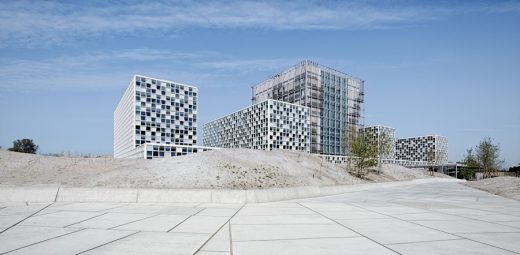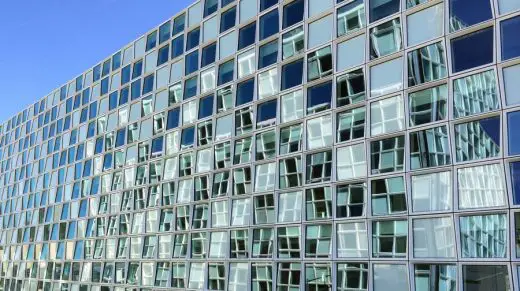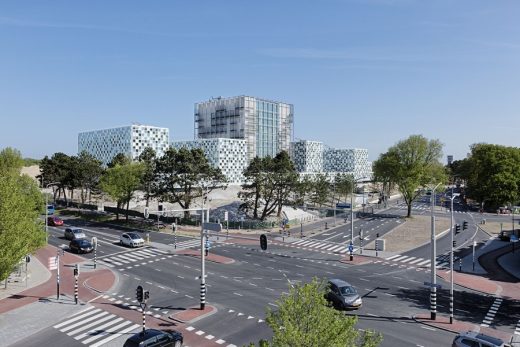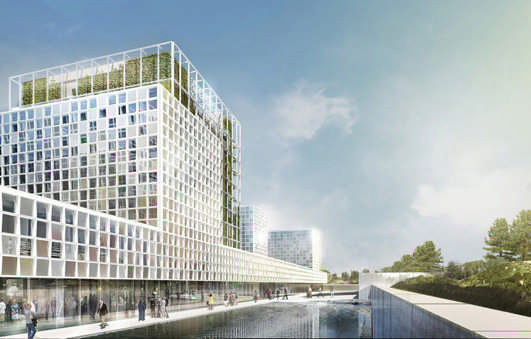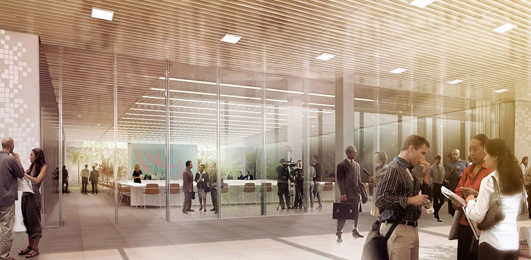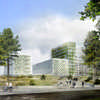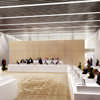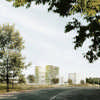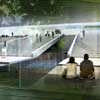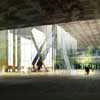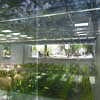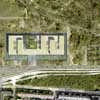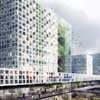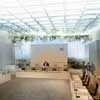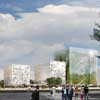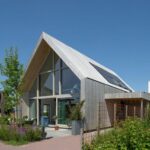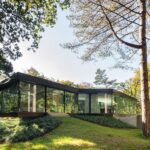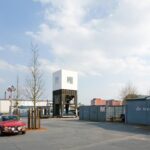International Criminal Court, ICC The Hague, Holland Building, Dutch Legal Project
International Criminal Court Holland : ICC Building
Project in The Hague, The Netherlands – design by schmidt hammer lassen architects
International Criminal Court Building in The Hague – Nov 2015 post with completed building photos
17 Apr 2013
International Criminal Court – ICC
The Hague, Holland
Design: schmidt hammer lassen architects
Ground-breaking ceremony for the International Criminal Court
A historical milestone was reached when the ground-breaking ceremony for the International Criminal Court (ICC) took place on Tuesday 16th April 2013 in The Hague, The Netherlands. Designed by schmidt hammer lassen architects to convey hope, trust and faith in justice, the 54,500 square metre building complex will be the first permanent premises of the unique, international institution.
The ICC is the first permanent, treaty-based, international criminal court established to help end impunity for the perpetrators of the most serious crimes of concern to the international community. It was founded in 2002 and has grown to the present-day size of 122 member countries.
“To the victims, to their families and to the world, the ICC premises must communicate respect, trust and hope. Therefore, this building cannot be anonymous; it must have the courage to express the values and the credibility of the ICC. As a consequence, the ground-breaking marks the transformation of the values of the ICC into physical reality,” explained Mr Bjarne Hammer, Founding Partner and Creative Director at schmidt hammer lassen architects.
Located close to the North Sea, the new Court building is set in the rolling dune landscape on the edge of The Hague. The main concept is a sculptural arrangement of buildings in the landscape. It appears as a landmark that expresses the eminence and authority of the ICC, while at the same time relating to a human scale.
schmidt hammer lassen architects won the prestigious architectural competition to design the permanent premises of the ICC in March 2010. Since then, the project has been developed in close collaboration with the client and the Municipality of The Hague. During the process, several user-group consultations have been conducted.
Key to the decisions made in the process has been to transform the values of the ICC – transparency and accessibility – to be an integrated part of the building design. Special attention has been paid to the development of a new custom-made facade system designed of a composite material known in the aviation and wind turbine industry.
The permanent premises of the International Criminal Court will be finished in the summer of 2015.
International Criminal Court Holland – Building Information
Architect: schmidt hammer lassen architects
Client: The International Criminal Court
Area: 54,500 m2 GFA with up to 1,200 work stations
Competition: 2008-10, won in restricted international competition
Status: Construction 2013-15
Engineer: Royal Haskoning Esbensen Consulting Engineers (in competition stage)
Interior Design and Art: Bosch & Fjord in collaboration with schmidt hammer lassen architects (in competition stage)
Landscape architect: SLA
Project management: Brink Groep
Contractor: Courtys
8 Mar 2010
International Criminal Court in The Hague
The Hague, Holland
Design: schmidt hammer lassen architects
schmidt hammer lassen architects wins the competition for the International Criminal Court in The Hague
After years of accommodation in temporary premises, the International Criminal Court (ICC) in The Hague has revealed its design for new permanent headquarters by schmidt hammer lassen architects (SHL). The Danish office was selected in a prestigious architectural design competition with a twenty strong international shortlist including David Chipperfield, Mecanoo Architecten, OMA/Search, Ingenhoven, Wiel Arets, and Kengo Kuma & Associates.
“To the victims, to their families and to the world, the ICC building must communicate respect, trust and hope. This building cannot be anonymous; it must have the courage to express the values and the credibility of the ICC,” said Bjarne Hammer, Co-Founding Partner and Creative Director of schmidt hammer lassen architects. He continued: “The building is designed as an abstract and informal sculpture in the landscape. This way, it becomes a backdrop for the ICC to communicate trust, hope, and most importantly, faith in justice and fairness.”
Located close to the North Sea, the new Court is placed between nature and city, set in the rolling dune landscape at the edge of The Hague. The main concept is the sculptural arrangement of buildings in the landscape and the design of a landmark that conveys the eminence and authority of the ICC while at the same time relating to a human scale. schmidt hammer lassen´s winning design complies with a complex brief and captures the spirit of the ICC. The overall building form can be seen as an undulating composition of volumes on the horizon, reminiscent of the dune landscape. “It was evident that connecting the dune landscape with the edge of the city had a striking potential. By designing a compact building with a small footprint, we propose to return the landscape to the city,” said Bjarne Hammer.
According to the Architectural Jury, the design provides the ICC with a sculptural composition of square towers. The Jury quoted this approach as “a very impressive and interesting architectural gesture and a great contribution to the city with an attractive integration into the landscape. This applies also for the idea of ‘moving down’ to the Court through the spacious staircase. The big and sharp incision in the landscape and the lower ground floor are very interesting elements. The inner atmosphere is confirmed as user-friendly, especially the spacious ground floor with beautiful daylight from above. This ground floor can be seen as an inner private park area which facilitates the interaction between all the ICC employees in a very pleasant and positive way.”
By making a sharp incision into the ground the building complex forms a contrast to the surrounding dune landscape. The architectural idea is to continue the gardens in the ground floor (parterre) level of the building as a cladding of the Court Tower.
“Gardens have always existed as part of all cultures and all religions. With flowers and plants from each of the 110 ICC member countries, the parterre gardens rise up as a green landmark and a symbol of unity, regardless of nationality and culture,” explained Bjarne Hammer.
Environmental sustainability is a key criterion in terms of the building’s footprint and the selection of building materials. The facades of the office buildings are clad in a composite material selected for its suitability to the windy and salty local climate, ease of maintenance and security performance. The material is normally used in the bodywork of professional race cars and in the cladding of windmills due to its durability. The design has at this stage been assessed as BREEAM Excellent.
International Criminal Court Netherlands – Building Information
Client: The International Criminal Court (ICC)
Area: 46,000 m2, up to 1,200 work places
Construction sum: €190 million ex. VAT
Competition: 2008-2010, restricted international competition with a total of 171 applications
Engineer: Royal Haskoning Nederland B.V.and Esbensen – Consulting Engineers AS
Interior design and art: Bosch & Fjord in collaboration with schmidt hammer lassen architects.
Previously:
The ICC is a tall, luminescent, sculptural composition of various-sized square towers, which are united at the bottom by a rectangular base sharply incised in the dunes.
The base – four and half metres high – is hovering above ground and the incision in the ground is wider and larger than the base itself. Six of the seven towers are draped in a light transparent pattern of rhombuses and so is the base they rest on. The rhombuses make up the slightly irregular glass panes through which there is a view of the surrounding trees and dunes. In the seventh and tallest tower, the ICC Courthouse resides.The façade of the courthouse is a relief of square timber panels. The warm wood colour of the courthouse sets it apart from the rest of the buildings.
The entrances are situated at each end of the complex 8 metres below the base. Here, you enter a public garden of trees and plants from all over the world grown in rhombus shaped mosaics of flowerbeds interspersed with reflecting pools. Blocks frame the public area containing meeting rooms, hot desks for the press, auditoriums, library and archives, staff restaurants. Interspersed between the pools and vegetation are restaurant pavilions for visitors.
The seven towers are set in a staggered row on their rectangular base. The buildings vary in height between four and seven storeys with the 37-metre courthouse towering in the middle. The six office towers mainly consist of office space and meeting and conference rooms. They rest on the stair cores and columns of various dimensions in the public garden.
ICC Building images / information from schmidt Hammer Lassen Architects
Location: The Hague, Netherlands, northern Europe
Den Haag Buildings
Design: MVSA Architects
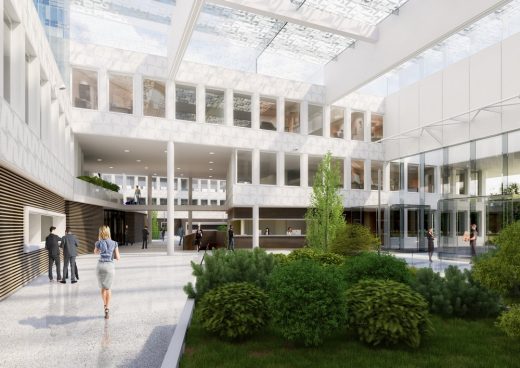
image © MVSA Architects
NATO Communications and Information Agency Den Haag
Design: Architekturbüro ZJA Zwarts & Jansma Architects / Knippers Helbig Advanced Engineering
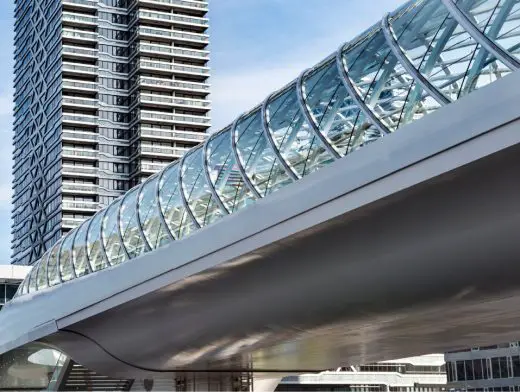
exterior image: Pietro Savorellit
Lightrailstation Den Haag
Voorlinden Museum Building, Wassenaar, province of South Holland
Design: Kraaijvanger Architects with Arup
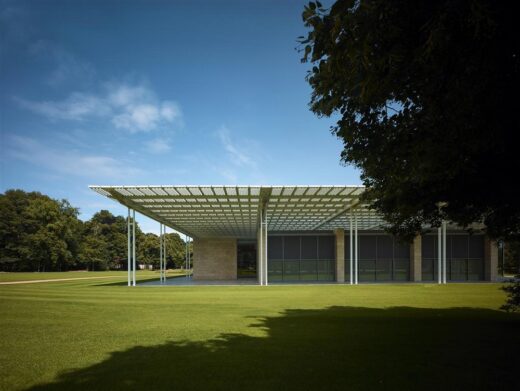
exterior image: Pietro Savorellit
Voorlinden Museum Building
Architecture in The Netherlands
Contemporary Dutch Architecture
Netherlands Architecture Designs – chronological list
Amsterdam Architecture Walking Tours by e-architect
Dutch Architecture – Selection
Schmidt Hammer & Lassen Architects
Comments / photos for the International Criminal Court Holland Architecture page welcome
Website: ICC – International Criminal Court

